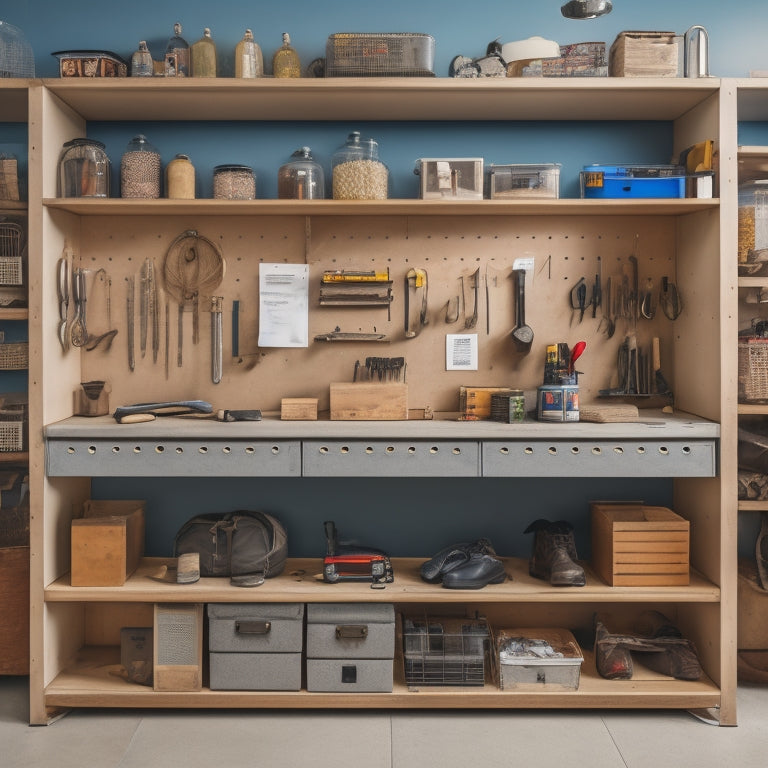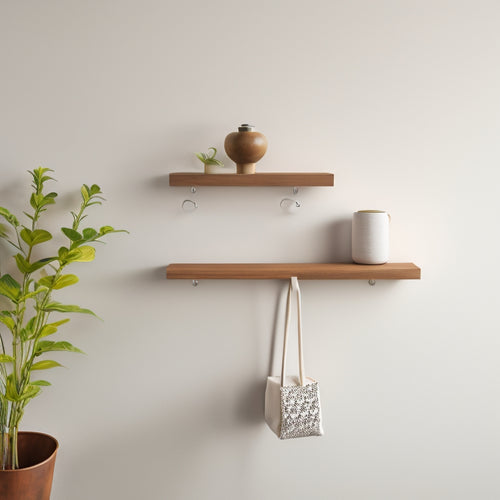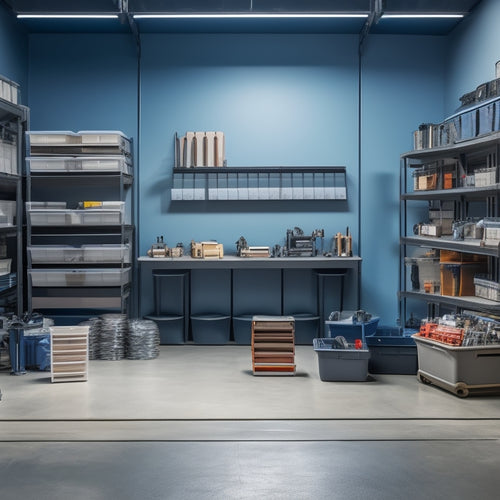
Optimize Your Space: 3 Essential Tool Storage Tips
Share
You can optimize your space by implementing three essential tool storage strategies. First, maximize vertical storage space by utilizing walls and ceilings with adjustable shelving units or pegboards with hanging hooks. Next, utilize hidden storage areas like the back of a door or inside a cabinet to create cleverly concealed compartments for infrequently used tools. Finally, designate a tool zone, a centralized hub for all your tools, grouping similar tools together for easy accessibility and categorizing them by project type. By following these tips, you'll be well on your way to a clutter-free workspace, and discover even more ways to boost your productivity.
Key Takeaways
• Maximize vertical storage space with adjustable shelving units, pegboards, and wall-mounted cabinets to free up floor space and protect tools.
• Utilize hidden storage areas like the back of doors, inside cabinets, and secret compartments to store infrequently used tools and supplies.
• Designate a tool zone with a centralized hub to streamline workflow, grouping similar tools together for easy accessibility and categorizing by project type.
• Label each section in the tool zone for quick tool retrieval, and allocate space according to the garage layout.
• Consider repurposing underutilized spaces to create cleverly concealed compartments for storing tools and supplies, keeping the workspace organized and clutter-free.
Maximize Vertical Storage Space
You can greatly increase your tool storage capacity by maximizing vertical storage space, which is especially useful in cramped workshops or garages.
By making the most of your walls and ceiling, you can free up valuable floor space and keep your tools organized and within reach.
Shelving solutions, such as adjustable shelving units or pegboards with hanging hooks, are great options for storing frequently used tools and accessories.
For less frequently used items, consider installing wall-mounted cabinets or compact organizers that can be easily accessed when needed.
These solutions not only save space but also keep your tools protected from dust and damage.
By maximizing your vertical storage space, you'll be able to store more tools and supplies, making it easier to find what you need when you need it.
This, in turn, will help you work more efficiently and effectively, saving you time and frustration in the long run.
Utilize Hidden Storage Areas
Beyond vertical storage solutions, cleverly concealed compartments and secret stashes can be created to stash infrequently used tools and accessories, keeping them out of the way yet still accessible.
You can repurpose underutilized spaces, like the back of a door or the inside of a cabinet, to create hidden storage areas. For instance, you can attach a pegboard or a storage rack to the back of a door, providing a convenient spot to hang tools and accessories.
You can also create secret compartments in your workbench or cabinets. Consider installing a sliding drawer or a hidden shelf to store items like paints, oils, or other supplies. These clever storage solutions will help you keep your workspace organized and clutter-free.
Designate a Tool Zone
By designating a specific area for your tools, you'll create a centralized hub that streamlines your workflow and saves time. This zone will become the go-to spot for all your tool-related needs, keeping you focused and efficient.
When designing your tool zone, consider the garage layout and allocate space accordingly. You can dedicate a section of the wall for pegboards, hooks, and bins, or invest in a tool cabinet or chest.
Tool organization is key to a well-functioning tool zone. Group similar tools together, such as all your hand tools or power tools, to make them easily accessible. You can also categorize tools by project type, like having a section for woodworking or automotive tools. Label each section or bin to make sure you can quickly find what you need.
Frequently Asked Questions
How Often Should I Clean and Organize My Tool Storage Area?
You should clean and organize your tool storage area regularly, ideally every 1-3 months, using techniques like categorizing, labeling, and assigning a home for each tool to maintain a clutter-free and efficient space.
Can I Use Baskets to Store Small Tools and Accessories?
While cluttered workbenches are a familiar sight, you're wise to contemplate tool organization. Yes, you can use baskets to store small tools and accessories, offering a tidy storage solution that keeps essentials within easy reach.
Are Stackable Storage Bins Suitable for Heavy Tools?
When storing heavy tools, you'll want stackable bins that can handle the weight, so check the weight capacity and look for durable, stable bins that won't topple or break under the load.
Can I Store Tools in a Humid or Damp Environment?
"When you're stuck between a rock and a hard place, storing tools in a humid environment can be a recipe for disaster, but you can prevent rust by sealing containers and taking rust-prevention measures to keep your tools in top shape."
How Do I Label My Tool Storage Bins for Easy Identification?
You'll easily find what you need by labeling your tool storage bins with color-coded labels and organizing them alphabetically, ensuring quick identification and saving you time and frustration in the process.
Related Posts
-

Small Storage Bins to Maximize Shelf Space
When maximizing shelf space, you want to make the most of every inch. Small storage bins are the answer, but choosing...
-

Wall Mounted Hooks With Shelf for Maximum Storage
You'll find that wall mounted hooks with a shelf are a revolutionary solution for maximizing storage in your home, pr...
-

How to Maximize Storage Space With Parts Storage Bins
To maximize storage space with parts storage bins, start by evaluating your available storage space and examining you...


